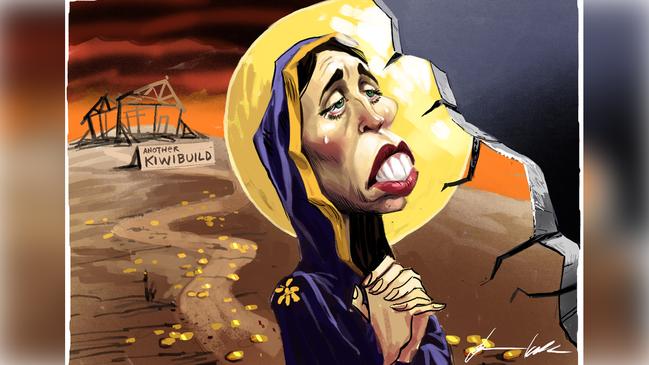
I get it: she’s young, a new mother with a stay-at-home partner and she’s from the Left. Also, in response to the Christchurch massacre, she has shown empathy and resolve. Within days she clamped down on New Zealand’s extraordinarily permissive gun laws.
But for those who follow that country’s politics, the deification of Jacinda Ardern is underpinned by an extraordinary selectiveness when it comes to assessing the real political person.
After all, she is prime minister only because she agreed to form a coalition with New Zealand’s version of One Nation, New Zealand First, headed by perennial politician Winston Peters.
At the 2017 election, New Zealand’s Labour Party, which Ardern leads, and NZ First received many fewer votes than the National Party led by then prime minister Bill English. The Nationals won 56 seats, Labour secured 46 and NZ First nine.
But with the Greens’ willingness to guarantee supply, Labour and NZ First went on to form a coalition government, with Ardern as prime minister.
Peters, whose politics can best be described as nationalist-populist, was rewarded with the deputy prime ministership while becoming Foreign Minister, State Owned Enterprises Minister and Racing Minister. Not a bad haul for a party that received 7 per cent of the vote.
It was a surprising outcome given the success of the previous National Party governments, first under prime minister John Key and then English. These two National Party leaders had artfully steered New Zealand through the ravages of the global financial crisis and the Christchurch earthquakes.
■ CUT & PASTE: An important reminder about Winston Peters
The budget was slowly repaired, some important tax and welfare reforms were implemented and the economy strengthened. Unemployment fell below 5 per cent and remains there.
An important debate at the 2017 election was the rate of immigration. Like Australia, New Zealand is popular with migrants and international students.
With a population of less than five million, the net migration intake in New Zealand has been about 50,000 to 60,000 a year. Its population growth, about 2 per cent, has often been higher than ours.
A corollary has been escalating house prices, particularly in Auckland. A combination of restrictive land release policies, low interest rates, accessible credit, foreign investment and immigration-driven population growth has contributed to high house prices and is a big political issue.
NZ First’s 2017 election campaign included an annual cap on the migrant intake of between 7000 and 15,000 of “seriously qualified” migrants who “could assimilate into New Zealand culture”.
Labor’s policy position was similarly pitched at reducing the intake. The plan was for the overall number to be reduced by between 20,000 and 30,000 each year.
This included 6000 to 10,000 fewer student visas “by limiting visa and ability to work for low-value courses”; 9000 to 12,000 fewer post-study work visas; and 5000 to 8000 fewer work visas. In other words, the plan was quite specific, with numbers attached.
As it pans out, the Ardern-Peters government has not managed to reduce the migrant intake, although it has placed a ban on any foreigner purchasing established real estate.
The failure to fulfil this clear election commitment might normally attract strong criticism, but the reaction so far has been muted.
And let’s be clear about another matter: New Zealand’s intake of refugees is trivial compared with the number entering Australia under a humanitarian visa.
Of course, Ardern has been happy to garner favourable press coverage criticising our offshore processing system and vaguely agreeing to take some refugees from Manus Island and Nauru.
But her country’s annual refugee intake had been just 750 until last year, when it was lifted to 1000. New Zealand’s refugee intake amounts to 0.02 per cent of its population compared with our 0.07 per cent.
Ardern also has stumbled with other policies, most notably KiwiBuild. The pledge was to build 100,000 additional affordable homes by 2028.
It has since been modified to facilitation by the government to help build new homes. Moreover, the definition of affordability has been altered from between $NZ350,000 ($340,000) and $NZ450,000 to $NZ650,000.
What started off as an ill-considered public housing project has turned out to be an extremely unsuccessful private real estate scam. The government estimated that there would be 1000 homes built last year under KiwiBuild; it turned out to be 47.
Ardern and Peters have other plans in the pipeline. The minimum wage is to be lifted to $NZ22 an hour next year, and from 2024 three-year university courses will be free.
There are plans to increase benefits under the seniors SuperGold Card, a pet project of Peters.
The bottom line is that the government under Ardern is pursuing a motley collection of well-worn policies that are based on providing more free stuff to people using other people’s money. We have seen where this ends in very many places.
Her government has talked the talk on restricting immigration but has failed to walk the walk. And recall that its citizens have an automatic right to enter and live in Australia.
If their economy turns pear-shaped, there is a strong possibility more New Zealanders, including those recently arrived migrants, could head over the ditch.
Just as premier Anna Bligh performed in an exemplary fashion during Queensland floods, and prime minister John Howard after the Port Arthur massacre and the Bali bombings, we expect our political leaders to behave in a compassionate and forthright manner in those circumstances. Ardern has lived up to this expectation.
But this doesn’t inoculate her from criticism as a political leader trying to run a country. On many fronts, her performance has been ordinary.




To join the conversation, please log in. Don't have an account? Register
Join the conversation, you are commenting as Logout